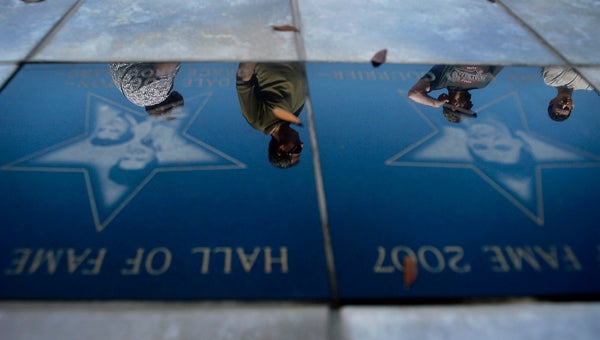Is bare-knuckle fighting poised for a US boom? Biloxi show drawing notice
Published 5:11 pm Friday, August 24, 2018
LOS ANGELES (AP) — David Feldman staged a bare-knuckle boxing match on the undercard of a mixed martial arts show at a Yavapai Nation casino in Arizona in 2011. The promoter offered the fight on the internet as a paid streaming option, just to see if anybody would watch it.
Feldman claims the pay-per-view system crashed under the demand of hundreds of thousands of buyers worldwide trying to watch two men fight with their bare fists.
He didn’t get paid, but that’s when Feldman knew this archaic sport had a future.
“This sport is absolutely not for everybody to compete in or watch,” Feldman said. “For some people, the blood, the fast pace and the excitement of the whole thing is not for everybody. But for the group that it is for, I think we deliver exactly what their appetite calls for.”
After nearly a decade of patient work to get this primal version of boxing formally sanctioned somewhere in the U.S., Feldman’s Bare Knuckle Fighting Championship debuted in Wyoming two months ago. The show captured wide-ranging attention online, where it sold about 150,000 pay-per-view buys and drew heavy chatter on social media.
Feldman’s BKFC promotion is staging a second show Saturday night in Biloxi, Mississippi, putting ungloved boxers in a ring for two-minute rounds filled with the primally compelling sound of flesh hitting flesh without padding or cushion. The card features a mishmash of experienced fighters from other disciplines, including MMA veterans Bec Rawlings, Kendall Grove and Chris Lytle.
Twenty-five years after the UFC’s debut, Feldman thinks regulated bare-knuckle boxing might be the next big worldwide thing in the so-called combat sports. British promoters have staged bare-knuckle bouts for years, but the North American pay-per-view market usually is the ultimate goal for any promoter hoping to cash in.
Even before his second bare-knuckle show, it’s clear Feldman has opened a door. Other North American companies are already rushing to get through it, but the veteran fight promoter believes he can build a company that will last.
“I think it’s whoever starts first, but starts right first,” Feldman said. “Like I told my partners, we can’t walk out of the starting box. We have to sprint. So if we sprint out of the starting box, it’s going to be hard to catch us. And I think that’s our model right now. We did sprint out of it on June 2, and now a lot of fighters are coming our way.”
In BKFC’s attempt to stay on top of a sport long dormant in North America, Feldman will put on a third show in October, and he hopes to stage a fourth in December. He plans eight shows in 2019, with four on pay-per-view and four on television.
Feldman’s goal isn’t just to stage bare-knuckle fights, which he could do without state sanctioning. He wants to build a fight brand with a recognizable, stable product that will compel steady fandom, just as the UFC began to do in 2005.
“Look, there’s going to be competition,” Feldman said. “Just as long as they do the right thing, and do it the way that we did it, then competition is going to be great for us. But because we came out so fast and so good, we did establish ourselves as the bare-knuckle brand right now.”
The top company also will need recognizable fighters, and that competition is already stiff. Another nascent promotion, the World Bare Knuckle Fighting Federation, has signed former NFL linebacker Shawne Merriman and well-known MMA stars Chris Leben and Phil Baroni to fight on a show in Wyoming in November.
But BKFC has a clear drawing card in Rawlings, the longtime UFC fighter who emerged as a figurehead for bare-knuckle fighting after her entertaining victory on BKFC’s first card. When the colorfully tattooed Australian mother of two contemplates this surprising detour in her combat sports career, Rawlings is both surprised and thrilled by the opportunity to be on the forefront of something new.
“This sport is made for me,” Rawlings said before a recent workout in California, where she based her training camp to get away from the Australian winter. “I kind of lost the love for MMA, just with all the things going on behind the scenes, the weight cuts, things like that. It’s really cool to just be excited to go in the gym and do what I love.”
Rawlings quickly took to the new sport with help from coaches who understood the intricacies of punching without gloves. She ends up with superficial bruises and swelling after a bare-knuckle fight, but nothing too different from what happens in an MMA fight with its small gloves.
Proper technique is a key to minimize the stress on a fighter’s fists and wrists, which are wrapped in distinguishing colors in BKFC bouts. An ability to fight in close quarters is also important, since the fighters begin their rounds in the center of the ring, just an arm’s length apart.
For Rawlings, it’s all a thrill.
“My only worry with my last (bare-knuckle) fight was, ‘Damn, I don’t want to hurt my hands,'” Rawlings said. “‘These are my moneymakers.’ I’ve got to absolutely 100 percent protect them. … Don’t hit the top of the (opponent’s) head. That’s really going to hurt. I found when I hit her in the chin a number of times, that also hurt. You want to go for the juicier, fleshier parts.”






